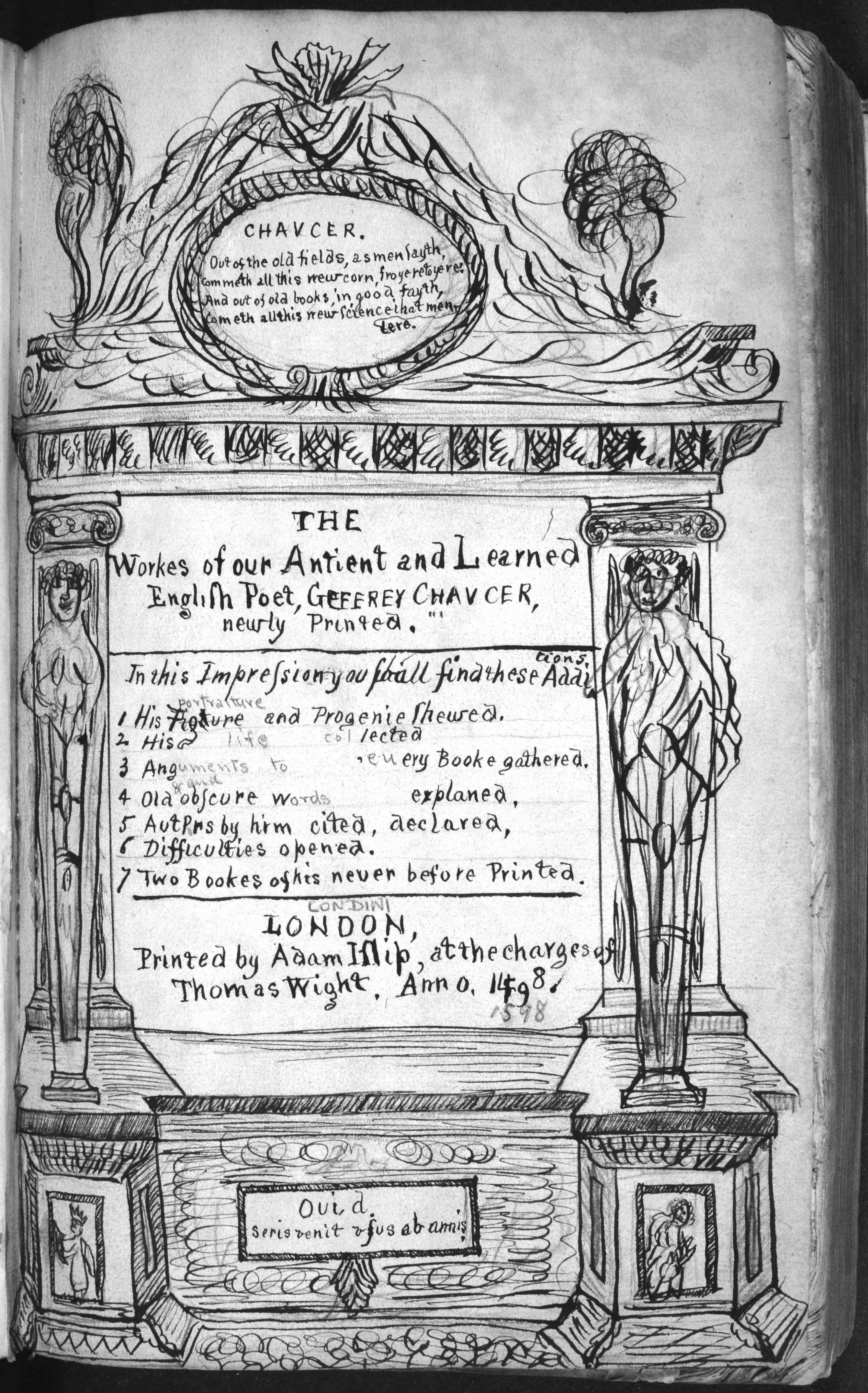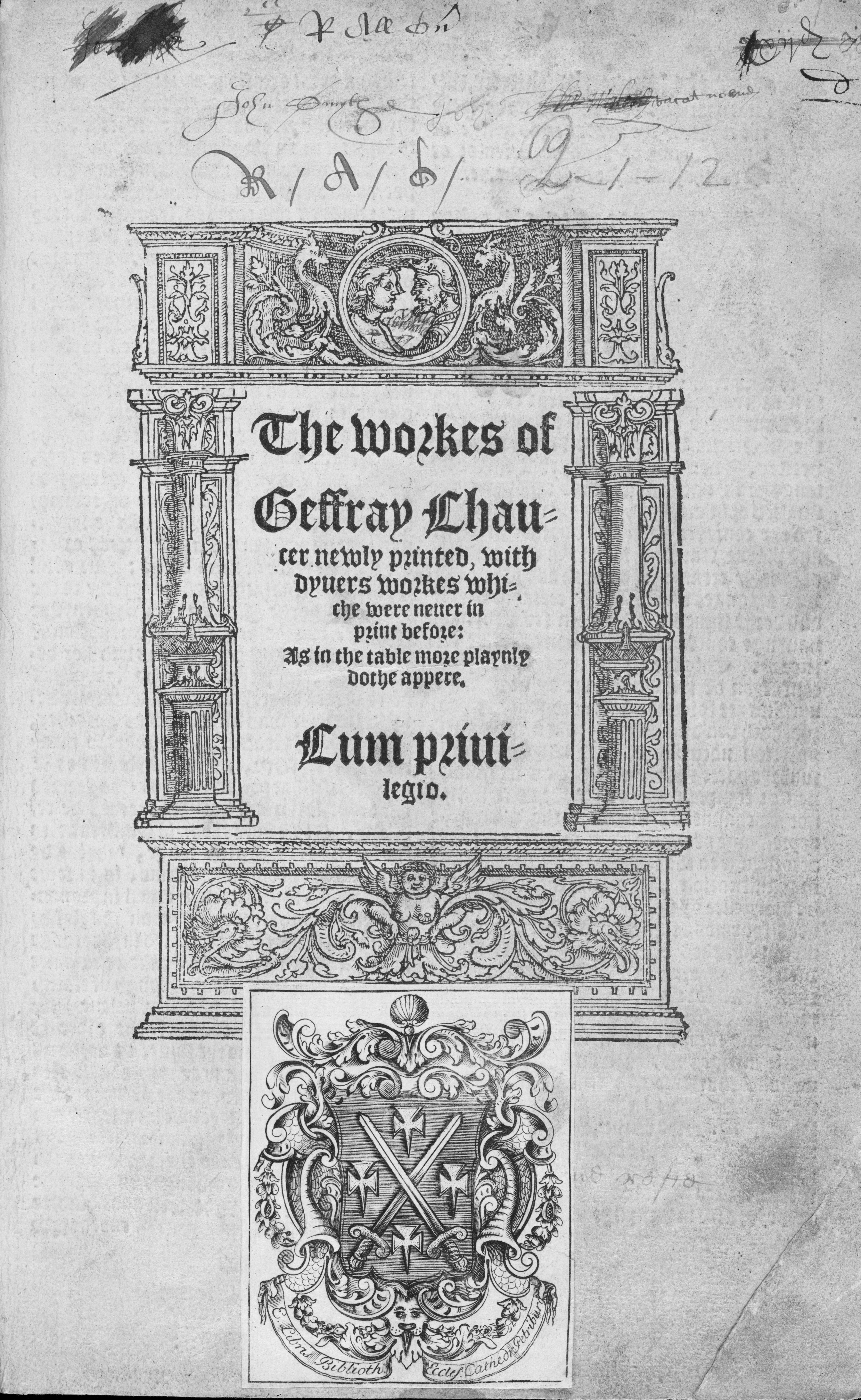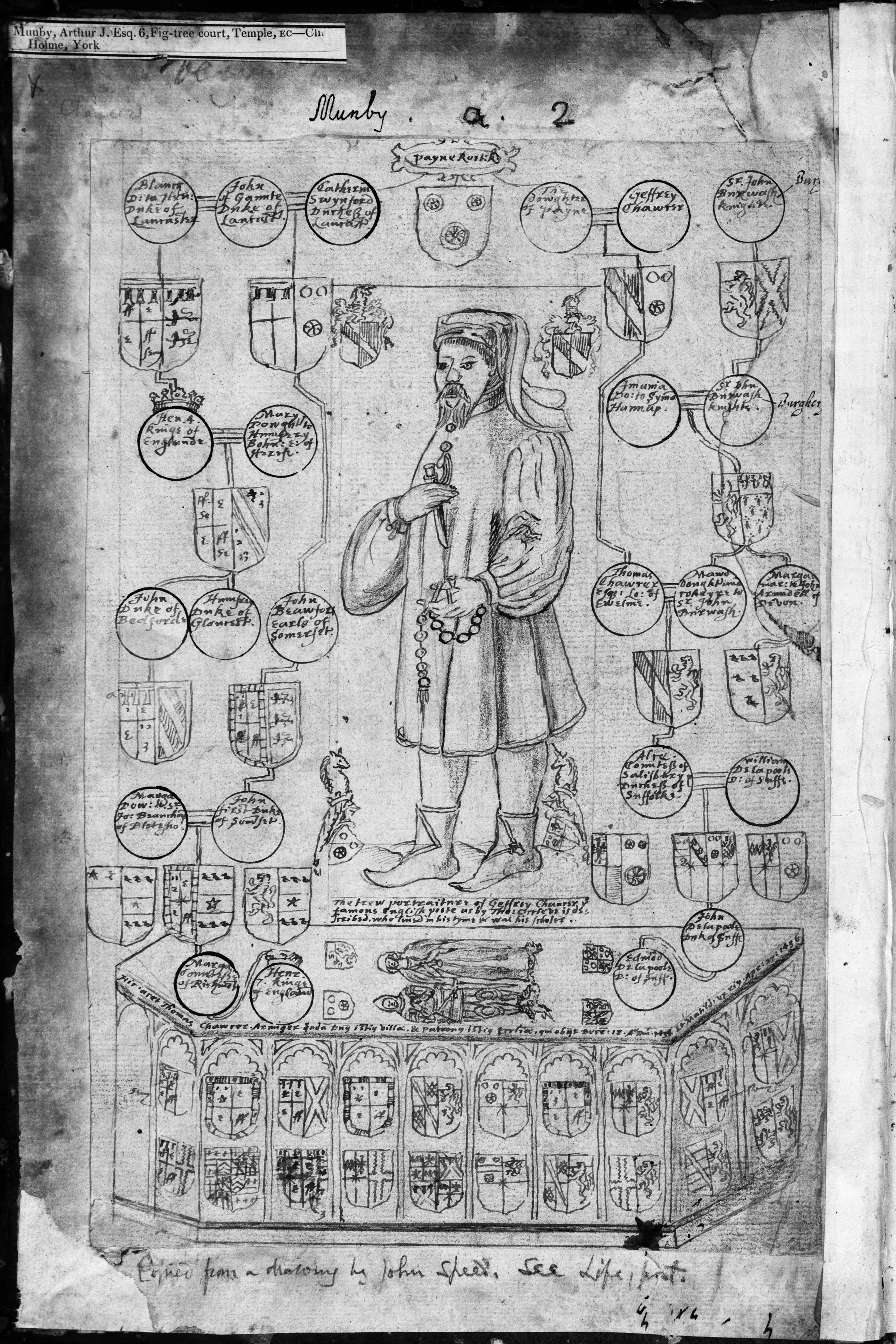|
READERS' MEMORIALS IN EARLY EDITIONS OF CHAUCER
| ||
Frontispiece Portraits
Portraits of the author also confer authority, and they sometimes were inserted to serve as a frontispiece in a copy printed without one (see table 2). Adding a portrait equals or exceeds in frequency the occasions where owners inscribed the tomb verses in copies printed without it. Thomas Speght's 1598 edition provides for the first time an engraved portrait of the author by John Speed. That printed image indicates that the artist used a Hoccleve manuscript as his model. Nicholas Perkins finds ample evidence that readers plundered Chaucer portraits from an early point in the transmission history of Hoccleve's De Regimine Principum, a mirror for princes completed ca. 1411, with the outcome that only one manuscript retains the Chaucer portrait, making it possible that Speght is referring to one of these lost images in his 1598 edition.31


FIGURE 11. Hand-drawn facsimile of Speght title page for a copy of Thynne's ca. 1550 edition. By permission of Wesleyan University Library, Special Collections & Archives (YX C4 1551).


FIGURE 12. Title page for Thynne's ca. 1550 edition with bookplate of Peterborough Cathedral. Reproduced by kind permission of the Syndics of Cambridge University Library (Pet. B.6.13).

| Edition Year | Location | Portrait |
| ca. 1477 | British Library (167.c.26), Canterbury Tales | s. xviii color portrait |
| 1532 | Oxford, Bodleian Library (Douce C. Subt. 19) | Hand-drawn facsimile of Hoccleve portrait (front board); Collyer engraving, 1774 (rear board) |
| ca. 1536 | Huntington Library (51789), Fack Upland | Collyer engraving, 1774 |
| 1542 | Columbia (Phoenix PO17.En1 B64 1542C). | s. xix color portrait |
| 1561 | Cambridge University Library (Keynes S.7.9) | Plate from Speght edition |
| 1561 | Huntington Library (84667) | Plate from Speght edition |
| 1561 | Texas, Harry Ransom Center (PR 1850 1561b, copy 4) | Thurston engraving, 1820 |
| 1561 | New York Public Library (*KC + 1561) | Plate from Speght edition |
| 1598 | Oxford, Bodleian Library (Ms Rawl. Poet 41) | Anon. sxvii printed stamp |
| 1602 | Baylor, Armstrong Browning Library (X BL 821.17 C496w) | Houbraken engraving, 1741 |
| 1602 | British Library (641.m.2) | Vertue portrait [n.d.] |
| 1602 | Texas, Harry Ransom Center (PR 1850 1602b) | Engraving for Baldwin, 1753 |
| 1602 | Harvard, Houghton Library (STC 5081) | s. xviii portrait |
| 1602 | Trinity College, Cambridge (Munby A. 2) | Hand-drawn facsimile of Speed portrait, in brown ink |
| 1602 | University of Virginia (PR1850 1602 copy 1) | Engraving for Harrison, 1785 |
Martha Driver argues, however, that Speed probably based his work on British Library MS Additional 5141 or a similar full-length depiction of Chaucer holding his penner and a rosary given how similar the styling is between the printed engraving and the painted image.32 She concurs with Derek Pearsall that this single leaf might be the Cotton portrait referred to by the eighteenth-century engraver George Vertue if someone liberated it from Cotton Otho A. XVIII before the manuscript perished in the fire of 1731.33 Some years after Vertue's engraving, dated 1717, Jacobus Hou-

Collectors of Chaucer's early printed editions added copies of half-body portraits to their Chaucer editions, pilfered from a variety of sources. The Houbraken portrait serves as a frontispiece for the Browning Chaucer. Another engraving of Chaucer's bust, printed for Robert Baldwin and the London Magazine in 1753, appears on the verso of a fly leaf in a Bishop imprint of the 1602 edition.37 An even later engraving by John Thurston (1820) can be found in a copy of the 1561 edition at the HRC. A copy of the 1532 edition once owned by Francis Douce (1757-1834) frames the body of the text with images of Chaucer on both the front and the rear pastedowns, opening with a tracing of the Hoccleve miniature and concluding with John Collyer's 1776 engraving.38 A copy of Speght's first edition contains at the start of the author's biography a small portrait that appears to be clipped from the title page to Edward Phillips' Moderne World of Words.39 In one case where the Speed portrait was wanting in a 1602 edition at Trinity College, Cambridge, the owner added a hand-drawn facsimile to serve in place of the engraved portrait (figure 13). Collectors might add extra portraits to copies of Speght's edition, even if the Speed portrait remained intact. Now did book owners have any qualms about robbing Peter to pay Paul by taking copies of the Speed portrait for use in earlier editions: a copy of John Stow's 1561 edition at the Cambridge University Library, for instance, contains a copy of the Speed portrait (Keynes S.7.9).


FIGURE 13. Hand-drawn facsimile of Speed portrait for Speght's 1602 edition. By permission of the Master and Fellows of Trinity College, Cambridge (Munby A.2).

The circulation of these portraits merits further exploration, but this collection of examples seems to indicate that Chaucer's visual presence added iconographic worth to books commemorating not just his literary skill but his perceived cultural importance.
The ways in which owners of early editions of Chaucer altered their books represent forms of reception that have yet to be considered fully. These readers did more than mark passages with marginalia; through their choice of inscriptions, title-page embellishments, and inserted portraits they sought to provide an overall characterization of the books and their author. These elements, intended as commemorative and meant to be seen and appreciated by others, offer additional ways in which the physical features of books can prompt fresh insights into the cultural perceptions and values of past ages.40

At the British Library, a copy of the Canterbury Tales appears to use text clipped from a running title to supply a title page (BL G.11587).
The extant copy is British Library MS Harley 4866, fol. 88. See Nicholas Perkins, Hoccleve's Regiment of Princes: Counsel and Constraint (Cambridge: D.S. Brewer, 2001), 155-159. He agrees with Pearsall that Speght's claim might have been a publicity ploy, but "it is quite possible, however, that he had seen such a portrait, whether the one described by [Sir Francis] Kinaston, or in a manuscript now lost, or in Arundel 38 or Harley 4826 before they were excised" (159).
Martha W. Driver, "Mapping Chaucer: John Speed and the Later Portraits," Chaucer Review 36 (2002): 228–249 at 241.
Derek Pearsall, Life of Geoffrey Chaucer: A Critical Biography (Oxford and Cambridge, MA: Blackwell, 1992), 295.
For further information about the engraving, see British Museum Collection Database, "1979,, U.366." www.Britishmuseum.org/collection.
The Sloane portrait is now National Portrait Gallery 532; see Marion Harry Spielmann, The Portraits of Geoffrey Chaucer: An Essay Written on the Occasion of the Quincentenary of the Poet's Death (London: Chaucer Society, 1900), 12.
Betsy Bowden wryly observes that "although traditional Chaucer portraiture constitutes an extensive topic, the basic image and pose remained quite consistent," making it no surprise that "the Houghton Library portrait on wood, done by an unknown artist perhaps in the seventeenth century, stands in a long line of sweet-faced, fork-bearded Chaucers who finger pen case and rosary while gazing pensively downward." See Bowden, "Canterbury Pilgrims and Their Horses in the Eighteenth Century: Two Artists' Interpretations," Harvard Library Bulletin, n.s. 3 (1992-93): 18–34 at 32.
|
READERS' MEMORIALS IN EARLY EDITIONS OF CHAUCER
| ||